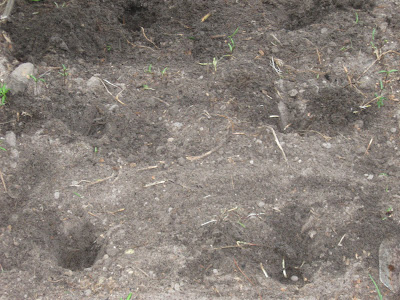You should have the soil ready by now, so mark planting holes about 18 inches on center:
Now, dig one hole with the small garden trowel to try to dry-fit the tomato into the hole:
We can see from the previous picture that the hole is too shallow, too much of the stem is above the ground. Usually we would want eighty percent of the seedling to be buried under to promote root growth from the stem as well as cool the roots and allow them to reach the moisture and nutrients. Dig some more dirt out and dry fit again:
Now it looks much better. We can gauge that most of the plant would be buried under the ground level.
Granted, my beds are double-dug to at least a foot deep so I can accommodate eight or ten inch hole for the transplants. If your beds cannot go as deep and the transplants are tall, you can horizontally lay them, that is dig the hole as deep as you can, put the transplant in and lay the rest of the stem on the ground, covering it with the soil. This will allow the roots to grow from the stem. The roots are the heart of the plant, the better developed the root system is, the healthier the plant will be.
To take the tomato out of it's container, we put the stem between index and middle finger and turn the container upside down:
Now gently lower the seedling and the root ball into the ground and fill with soul tapping around the stem lightly. As we can see, most of the transplant is covered with the soil, just leaving the top leaves above the ground. You do not have to repeat this process for each of the transplants. Generally, the soil in you garden will be of the same relative depth, so you only have to try one transplant to determine the depth of the holes for the rest of them.
An old Indian tale goes that you should put a banana peel and an egg into each tomato hole. This tale has merit; banana peels provide potassium and an egg provides calcium to the growing tomato seedling. When an egg decomposes, it provides sulfur for the fruit. In my garden banana peels, egg shells and other organic waste is added constantly to the soil, but if you are planting in a new garden, or a garden that is not very fertile, this Indian advice is worth a try.
Water the seedling at the stem thoroughly. Keep watering if there is no rain, every day for about a week, that's how long it takes for it to get established. After that, again, if there is no rain, water every other day or twice a week. A good rule of thumb, literally, is to stick a finger into the ground and see if it feels moist at the second knuckle. If it does not, water. I usually give my tomatoes a half-gallon watering twice a week at the stem, not overhead.















0 comments:
Post a Comment